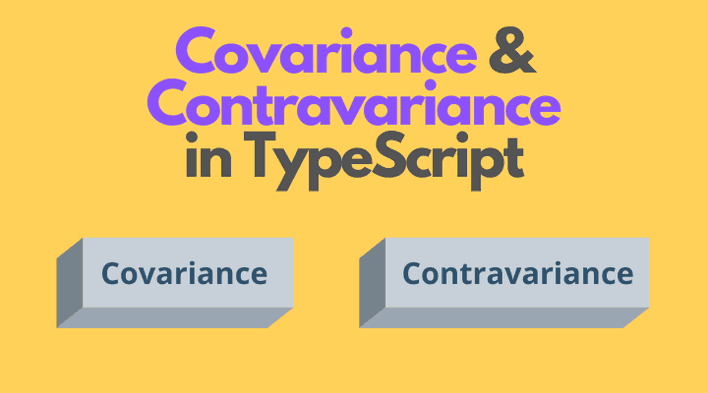Learning covariance and contravariance in TypeScript could be tricky (I know from my experience!), but knowing them is a great addition to understanding types and subtyping.
In this post, you'll read an accessible explanation of covariance and contravariance concepts.
1. Subtyping
Subtyping is a form of polymorphism in which a subtype is associated with a base type by some form of substitutability.
The substitutability means that a variable of base type can also accept subtype values.
For example, let's define a base class User and a class Admin that extends User class:
class User { username: string; constructor(username: string) { this.username = username; }}class Admin extends User { isSuperAdmin: boolean; constructor(username: string, isSuperAdmin: boolean) { super(username); this.isSuperAdmin = isSuperAdmin; }}
Since Admin extends User (Admin extends User), you could say that Admin is a subtype of the base type User.
The substitutability of Admin (subtype) and User (base type) consists, for example, in the ability to assign to a variable of type User an instance of type Admin:
const user1: User = new User('user1'); // OKconst user2: User = new Admin('admin1', true); // also OK
How can you benefit from the substitutability?
One of the great benefits is that you can define behavior that doesn't depend on details. In simple words, you can create functions that accept the base type as a parameter, but then you can invoke that function with subtypes.
For example, let's write a function that logs the user name to the console:
function logUsername(user: User): void { console.log(user.username);}
This function accepts arguments of type User, Admin, and instances of any other subtypes of User you might create later. That makes logUsername() more reusable and less bothered with details:
logUsername(new User('user1')); // logs "user1"logUsername(new Admin('admin1', true)); // logs "admin1"
1.1 A few helpers
Now let's introduce the symbol A <: B — meaning "A is a subtype of B".
Because Admin is a subtype of User, now you could write shorter:
Admin <: User
Let's also define a helper type IsSubtypeOf<S, P>, which evaluates to true if S if a subtype of P, and false otherwise:
type IsSubtypeOf<S, P> = S extends P ? true : false;
IsSubtypeOf<Admin, User> evaluates to true because Admin is a subtype of User:
type T11 = IsSubtypeOf<Admin, User>; // true
Subtyping is possible for many other types, including primitives and built-in JavaScript types.
For example, the literal string type 'Hello' is a subtype of string, the literal number type 42 is a subtype of number, Map<K, V> is a subtype of Object.
type T12 = IsSubtypeOf<'hello', string>; // truetype T13 = IsSubtypeOf<42, number>; // truetype T14 = IsSubtypeOf<Map<string, string>, Object>; // true
2. Covariance
Let's think about some asynchronous code that fetches User and Admin instances. Working with async code requires dealing with promises of User and Admin: Promise<User> and <: Promise<Admin>.
Here's an interesting question: having Admin <: User, does it mean that Promise<Admin> <: Promise<User> holds as well?
Let's make the experiment:
type T21 = IsSubtypeOf<Promise<Admin>, Promise<User>> // true
Having Admin <: User, then Promise<Admin> <: Promise<User> indeed holds true. This demonstrates that Promise type is covariant.
Here's a definition of covariance:
A type
Tis covariant if havingS <: P, thenT<S> <: T<P>.
The covariance of a type is intuitive. If Admin is a subtype of User, then you can expect Promise<Admin> to be a subtype of Promise<User>.
Covariance holds for many types in TypeScript.
A) Promise<V> (demonstrated above)
B) Record<K,V>:
type RecordOfAdmin = Record<string, Admin>;type RecordOfUser = Record<string, User>;type T22 = IsSubtypeOf<RecordOfAdmin, RecordOfUser>; // true
C) Map<K,V>:
type MapOfAdmin = Map<string, Admin>;type MapOfUser = Map<string, User>;type T23 = IsSubtypeOf<MapOfAdmin, MapOfUser>; // true
3. Contravariance
Now let's consider the following generic type:
type Func<Param> = (param: Param) => void;
Func<Param> creates function types with one parameter of type Param.
Having Admin <: User, which of the expressions is true:
Func<Admin> <: Func<User>, orFunc<User> <: Func<Admin>?
Let's take a try:
type T31 = IsSubtypeOf<Func<Admin>, Func<User>> // falsetype T32 = IsSubtypeOf<Func<User>, Func<Admin>> // true
Func<User> <: Func<Admin> holds true — meaning that Func<User> is a subtype of Func<Admin> . Note that the subtyping direction has flipped compared to the original types Admin <: User.
Such behavior of Func type makes it contravariant. Speaking generally, function types are contravariant in regards to their parameter types.
A type
Tis contravariant if havingS <: P, thenT<P> <: T<S>.
The subtyping direction of function types is in the opposite direction of the subtyping of the parameter types.
type FuncUser = (p: User) => void;type FuncAdmin = (p: Admin) => void;type T31 = IsSubtypeOf<Admin, User>; // truetype T32 = IsSubtypeOf<FuncUser, FuncAdmin>; // true
4. Functions subtyping
What is interesting about functions subtyping is that it combines both covariance and contravariance.
A function type is a subtype of a base type if its parameter types are contravariant with the base type' parameter types, and the return type is covariant* with the base type' return type.
*when strictFunctionTypes mode is enabled.
In other words, the subtyping for functions requires that the parameter types be contravariant, while the return types covariant.
For example:
type SubtypeFunc = (p: User) => '1' | '2';type BaseFunc = (p: Admin) => string; type T41 = IsSubtypeOf<SubtypeFunc, BaseFunc> // true
SubtypeFunc <: BaseFunc because:
A) parameter types are contravariant (subtyping direction flipped User :> Admin)
B) return types are covariant (same subtyping direction '1' | '2' <: string).
Knowing subtyping greatly helps to understand the substitutability of function types.
For example, having a list of Admin instances:
const admins: Admin[] = [ new Admin('john.smith', false), new Admin('jane.doe', true), new Admin('joker', false)];
What types of callbacks does the admins.filter(...) accept?
Obviously, it accepts a callback with one parameter of type Admin:
const admins: Admin[] = [ new Admin('john.smith', false), new Admin('jane.doe', true), new Admin('joker', false)];const superAdmins = admins.filter((admin: Admin): boolean => { return admin.isSuperAdmin;});console.log(superAdmins); // [ Admin('jane.doe', true) ]
But would admins.filter(...) accept a callback which parameter type is User?
const jokers = admins.filter((user: User): boolean => { return user.username.startsWith('joker');});console.log(jokers); // [ Admin('joker', false) ]
Yes, admins.filter() accepts (admin: Admin) => boolean base type, but also its subtypes like (user: User) => boolean.
If a higher-order function accepts callbacks of a specific type, e.g. (admin: Admin) => boolean, then you can also supply callbacks that are subtypes of the specific type, e.g. (user: User) => boolean.
5. Conclusion
The type T is covariant if having 2 types S <: P, then T<S> <: T<P> (the subtyping direction is maintained). An example of a covariant type is the Promise<T>.
But if T<P> <: T<S> (the subtyping is flipped), then T is contravariant.
The function type is contravariant by the parameter types, but covariant by the return types.
Challenge: What other covariant or contravariant types do you know?


